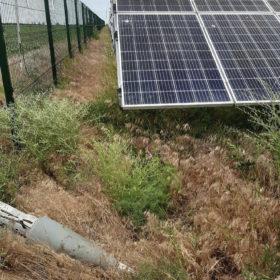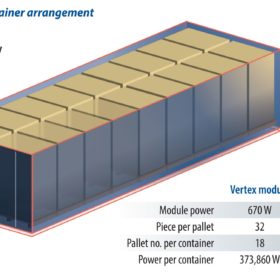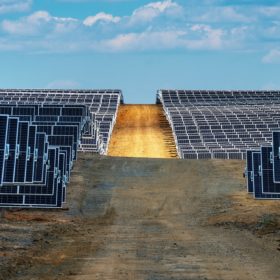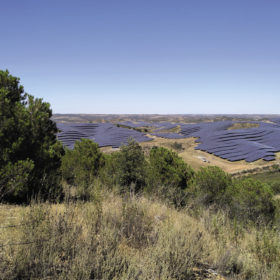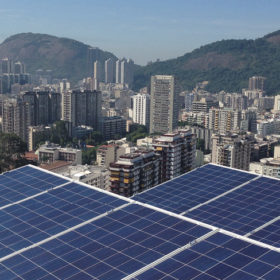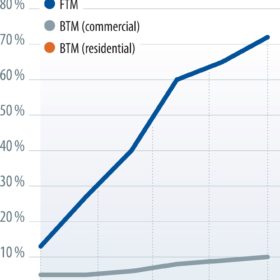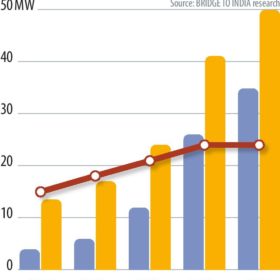Energy on the front line
Russia’s ongoing assault on Ukraine’s energy infrastructure, with missile and drone strikes, has seen the country’s power cut by nearly one-third, triggering widespread outages across the nation. With winter coming, the Ukrainian authorities haven’t ruled out a worst-case scenario that would see much of Kyiv, with its population of almost 3 million, evacuated from the city, reports Ian Skarytovsky.
On track for cost reduction
Large-format modules have become the industry standard for new utility-scale solar installations, with the conversation now shifting to the optimal wafer size: 210 mm or 182 mm. However, some difficulties persist in switching to the new standard, and a significant portion of the effort has fallen to tracker manufacturers. To gain a better perspective on what has changed, pv magazine’s Tim Sylvia sat down with three of the largest tracker manufacturers – Trina Solar, Nextracker, and Array Technologies – to discuss the common themes of availability, optimization and standardization.
Buyer power in a tight PV module market
Material shortages, trade restrictions, and shipping bottlenecks create challenges for PV module buyers, but the good news is that there are steps to take to ensure quality supply in a timely fashion. PVEL CEO Jenya Meydbray takes us through best practice for module buyers in the current market climate.
Backtracking is becoming smart, but it isn’t magic
Higher energy yields and a better distribution of generation over the day are the two key advantages that explain the success of single-axis trackers for PV generation in sunny places like Southern Europe, the Middle East, North Africa, or North America. As the scale of new tracker projects is increasingly reaching hundreds of megawatts, finding suitable large plots of affordable, flat land is not as easy as before. Everoze partner Felipe Canto Teixeira highlights the increased complexity in the design and energy assessment created by more challenging topographies, and discusses solutions based on his on-the-ground experience in hilly Portuguese terrain.
Tapping the data trail
US-based energy tech company Enphase Energy appears to have overcome the adversity it faced in the mid-2010s, when it was grappling with competition from string inverters and slower growth in the residential segment. Now that rooftop solar is hot again, Enphase’s co-founder and chief product officer, Raghu Belur, sat down with Tristan Rayner to discuss the microinverter pioneer’s approach to quality in a time of rapid change and the growing utility of connected devices.
Enormous potential
Portugal’s PV tenders have generated headlines on the back of world-record tariffs. But the country has failed to add meaningful capacity and is now struggling to establish a workable licensing system. Merchant solar shows enormous potential to drive the market, but will politicians listen?
The power of the prosumer
Under Brazil’s regulation, systems of up to 5 MW can be classed as distributed generation. The segment is forecast to account for 9 GW of the 12 GW of new PV that Brazil is set to install this year.
Dropping in on Kenya
Kenyans are “curious and quick to adopt new things,” Drop Access CEO Norah Magero tells pv magazine. But skepticism about new tech is only natural, so the NGO is trying to drive the adoption of solar panels, solar pumps, and solar refrigeration by increasing energy literacy.
China’s policy-driven battery boom
The rise of electric vehicles brings rapid technological advancement and cost reductions to lithium ion battery manufacturing, which can serve to make batteries more useful and more profitable for the energy storage industry. However, the use of stationary batteries as energy assets is still at a nascent stage. Most markets and business models are immature, and InfoLink analyst Yuan Fang-wei sees policy as the major driving force to lead and stimulate China’s energy storage market.
Strong prospects to ‘Make in India’
India’s renewable energy sector, having so far focused almost solely on adding more generation capacity with ever lower tariffs, is undergoing a drastic change, as policy pivots toward domestic manufacturing. Vinay Rustagi, managing director of Bridge to India, looks at how the border conflict with China and endless supply side disruptions in the wake of Covid-19 have together strengthened the Indian government’s resolve to support the establishment of a more localized supply chain.
